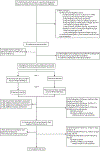A randomized double-blinded trial to assess recurrence of systemic allergic reactions following COVID-19 mRNA vaccination
- PMID: 38460680
- PMCID: PMC11162316
- DOI: 10.1016/j.jaci.2024.03.001
A randomized double-blinded trial to assess recurrence of systemic allergic reactions following COVID-19 mRNA vaccination
Abstract
Background: Systemic allergic reactions (sARs) following coronavirus disease 2019 (COVID-19) mRNA vaccines were initially reported at a higher rate than after traditional vaccines.
Objective: We aimed to evaluate the safety of revaccination in these individuals and to interrogate mechanisms underlying these reactions.
Methods: In this randomized, double-blinded, phase 2 trial, participants aged 16 to 69 years who previously reported a convincing sAR to their first dose of COVID-19 mRNA vaccine were randomly assigned to receive a second dose of BNT162b2 (Comirnaty) vaccine and placebo on consecutive days in a blinded, 1:1 crossover fashion at the National Institutes of Health. An open-label BNT162b2 booster was offered 5 months later if the second dose did not result in severe sAR. None of the participants received the mRNA-1273 (Spikevax) vaccine during the study. The primary end point was recurrence of sAR following second dose and booster vaccination; exploratory end points included biomarker measurements.
Results: Of 111 screened participants, 18 were randomly assigned to receive study interventions. Eight received BNT162b2 second dose followed by placebo; 8 received placebo followed by BNT162b2 second dose; 2 withdrew before receiving any study intervention. All 16 participants received the booster dose. Following second dose and booster vaccination, sARs recurred in 2 participants (12.5%; 95% CI, 1.6 to 38.3). No sAR occurred after placebo. An anaphylaxis mimic, immunization stress-related response (ISRR), occurred more commonly than sARs following both vaccine and placebo and was associated with higher predose anxiety scores, paresthesias, and distinct vital sign and biomarker changes.
Conclusions: Our findings support revaccination of individuals who report sARs to COVID-19 mRNA vaccines. Distinct clinical and laboratory features may distinguish sARs from ISRRs.
Keywords: Anaphylaxis; COVID-19; ISRR; PEG; allergic reaction; immunization stress-related response; mRNA; vaccine.
Copyright © 2024 The Authors. Published by Elsevier Inc. All rights reserved.
Conflict of interest statement
DECERATION OF CONFLICT OF INTEREST
L. Chatman is employed by the Kelly contracting agency at NIAID, NIH. E. P. Feener is an employee of KalVista Pharmaceuticals, Inc. S. K. Lai receives funding from the following grants: R01 HL141934 and 3UM1AI109565–08S1, is a founder of Polyon pharmaceuticals, has a patent on methods to overcome anti-PEG antibodies licensed by Polyon Pharmaceutical from the University of North Carolina, Chapel Hill and has consulted for Takeda on the topic of anti-PEG antibodies. L. B. Schwartz invented the tryptase assay licensed to ThermoFisher by VCU and royalties received by VCU are shared with L. B. Schwartz. All other authors declare no competing interests.
Figures




References
-
- Greenhawt M, Abrams EM, Shaker M, Chu DK, Khan D, Akin C, et al. The Risk of Allergic Reaction to SARS-CoV-2 Vaccines and Recommended Evaluation and Management: A Systematic Review, Meta-Analysis, GRADE Assessment, and International Consensus Approach. J Allergy Clin Immunol Pract. 2021. Oct;9(10):3546–3567. - PMC - PubMed
-
- Kelso JM, Greenhawt MJ, Li JT, Nicklas RA, Bernstein DI, Blessing-Moore J, et al. Adverse reactions to vaccines practice parameter 2012 update. J Allergy Clin Immunol. 2012. Jul;130(1):25–43. - PubMed
Publication types
MeSH terms
Substances
Grants and funding
LinkOut - more resources
Full Text Sources
Medical
Miscellaneous

